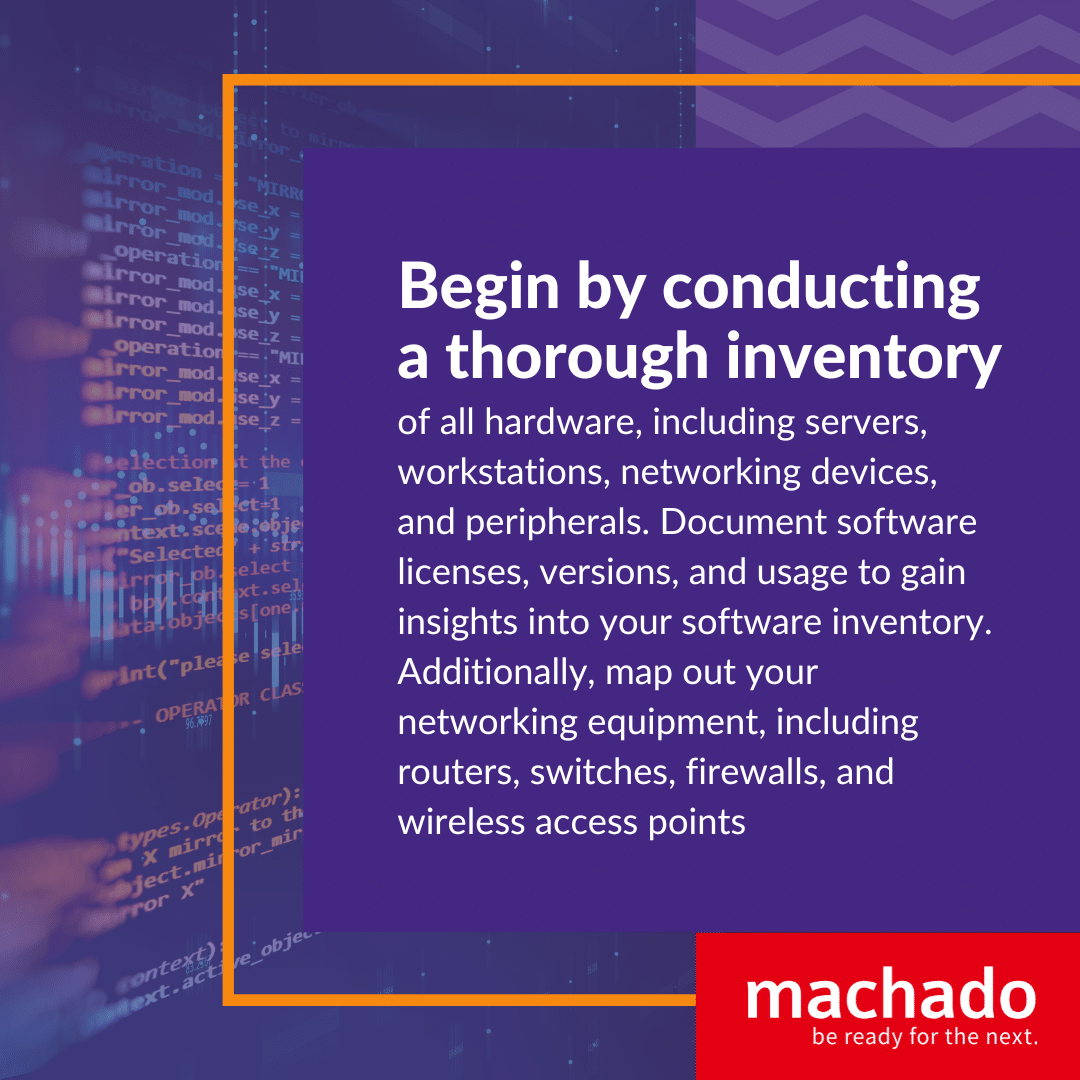How to determine your IT needs, even if you don’t have in-house IT support
In today’s fast-paced business landscape, professional services must continuously adapt to changing technology trends and align their IT infrastructure with their strategic goals to drive operational efficiency. Conducting an IT needs assessment is a vital step in this journey, allowing you to identify gaps, optimize resources, and unlock your company’s true potential.
In this blog, we explore the importance of conducting an in-house IT needs assessment and guide professional services providers (especially if you don’t have a dedicated IT person) on how to get started.
Understanding Your IT Needs Assessment
Your IT needs assessment involves evaluating the current state of your technology infrastructure and identifying areas that need improvement.
An IT needs assessment is a comprehensive evaluation of your organization’s technology assets, processes, and user requirements. It aims to identify strengths, weaknesses, and opportunities for improvement, ensuring that technology aligns with business goals.
While it may seem challenging without dedicated IT personnel, conducting an in-house assessment brings several benefits, including:
In-house assessments allow for a more intimate understanding of your organization’s operations, challenges, and user needs. This familiarity can provide valuable insights that may be missed with an outsourced assessment.
An in-house assessment can be tailored to your organization’s specific needs and budgetary constraints, offering a cost-effective alternative to hiring external consultants.
Preparing for Your Assessment
Before diving into the assessment process, it’s crucial to lay a solid foundation. Follow these steps to prepare for an effective IT needs assessment:
Identifying Key Stakeholders and Forming an Assessment Team
Involve key stakeholders from different departments to ensure diverse perspectives and comprehensive insights. This cross-functional assessment team should include representatives from management, operations, finance, and any other relevant areas.
Defining Objectives and Scope of the Assessment
Clearly define the goals, objectives, and scope of the assessment. This includes identifying specific areas to evaluate, such as hardware, software, networking, security, and user requirements. Align the assessment objectives with your organization’s strategic goals to drive meaningful outcomes.
Gathering Relevant Information and Documentation
Gather and review all relevant information and documentation, including:
- Inventory of hardware and software assets
- Network infrastructure diagrams
- Existing contracts and service-level agreements
- Operational processes and workflows
- User feedback and pain points
This data will provide a comprehensive overview of your current IT landscape, enabling a more informed assessment.
By understanding the purpose of an IT needs assessment and properly preparing for the process, you lay the groundwork for a successful in-house assessment. In the next part we examine the steps involved in conducting an effective IT needs assessment, guiding you through each stage to unlock the full potential of your business.
Unveiling Your IT Landscape: Assessing Infrastructure and User Needs
Conducting an in-house IT needs assessment empowers business leaders to optimize their technology infrastructure and enhance operational efficiency.
In the following we explore the crucial steps of identifying the current IT infrastructure and assessing business processes and user requirements.
By digging into these areas, you’ll gain valuable insights into their technology landscape and pave the way for meaningful improvements.
Identify Current IT Infrastructure and Systems
To gain a comprehensive understanding of your organization’s technology landscape, follow these essential steps:
A. Take Inventory of Hardware, Software, and Networking Equipment:
Begin by conducting a thorough inventory of all hardware, including servers, workstations, networking devices, and peripherals. Document software licenses, versions, and usage to gain insights into your software inventory. Additionally, map out your networking equipment, including routers, switches, firewalls, and wireless access points.
B. Document Existing Systems and Applications:
Document all existing systems, applications, and databases utilized within your organization. Include details such as their purpose, functionalities, and interdependencies. This documentation will serve as a foundation for assessing their effectiveness and identifying potential areas for improvement.
C. Assess the State of Infrastructure and Identifying Pain Points:
Evaluate the state of your infrastructure by analyzing performance metrics, system logs, and user feedback. Identify pain points, recurring issues, and areas where performance falls short of expectations. This assessment will help prioritize necessary improvements and address critical areas affecting operational efficiency.
Assess Business Processes and User Requirements
Understanding your organization’s business processes and user requirements is crucial to aligning technology with your operational needs. Follow these steps for a comprehensive assessment:
A. Conduct Interviews with Key Personnel to Understand IT Needs:
Engage key personnel from different departments in interviews or focus groups to gather insights into their IT needs and pain points. Explore their current workflows, challenges they face, and areas where technology can play a role in enhancing efficiency. Pay attention to feedback regarding existing systems and their usability.
B. Identify Bottlenecks, Inefficiencies, and Areas for Improvement:
Analyze the information gathered from interviews to identify bottlenecks, inefficiencies, and areas where processes can be streamlined. Look for opportunities to automate manual tasks, eliminate duplication, and enhance collaboration. These insights will help drive process improvements and technological advancements.
C. Analyzing User Requirements and Expectations:
Consider the unique requirements and expectations of your users. Analyze their preferences, work styles, and technology needs. Understand their expectations from the IT infrastructure, such as performance, accessibility, and ease of use. Incorporate user feedback into the assessment to ensure technology solutions meet their needs effectively.
By conducting a comprehensive assessment of your IT infrastructure and understanding your organization’s business processes and user requirements, you lay the groundwork for informed decision-making and strategic improvements. In the next part of this blog series, we will explore the subsequent steps in conducting an in-house IT needs assessment, guiding you through the journey of optimizing your technology ecosystem.
>>>Call-to-Action: Subscribe to our newsletter to receive Part IV directly in your inbox and gain insights on how to align your IT infrastructure with your organization’s goals for enhanced efficiency and security.<<<
Fortifying Your Foundation: Evaluating Security, Compliance, and Future Goals
Now that you’ve assessed your processes and user requirements, it’s time to start evaluating your security and compliance needs, as well as analyzing future business goals and industry trends. By conducting these assessments, organizations can ensure robust security measures, compliance with regulations, and technological alignment with their strategic objectives.
In the following section, we’ll explore the crucial steps involved in these areas.
Evaluating Security and Compliance Needs
To safeguard your organization’s valuable assets and ensure compliance with regulations, follow these essential steps:
A. Assess Existing Security Measures and Protocols:
Begin by conducting a thorough evaluation of your organization’s existing security measures and protocols. Assess the effectiveness of firewalls, antivirus software, intrusion detection systems, and other security mechanisms in place. Identify any potential vulnerabilities or gaps in your current security posture.
B. Identify Vulnerabilities and Compliance Gaps:
Perform a comprehensive vulnerability assessment to identify potential weaknesses in your IT infrastructure. This assessment may include penetration testing, vulnerability scanning, and security audits. Additionally, review applicable regulatory frameworks and industry standards to identify any compliance gaps.
C. Determine the Need for Data Protection, Access Controls, and Disaster Recovery:
Based on the assessment of security measures and compliance requirements, determine the need for data protection mechanisms, access controls, and disaster recovery plans. This evaluation will help prioritize investments in encryption, user authentication, backup solutions, and business continuity strategies.
Analyze Future Business Goals and Industry Trends
To stay ahead of the curve and align your IT infrastructure with future growth and innovation, consider the following steps:
A. Identify Your Organization’s Strategic Objectives:
Engage with key stakeholders to identify and understand the organization’s strategic objectives. Evaluate how technology can support and enable the achievement of these goals. This alignment ensures that your IT infrastructure serves as an enabler for the organization’s overall success.
B. Research Industry Trends and Emerging Technologies:
Stay informed about industry trends, emerging technologies, and best practices relevant to your business sector. Research advancements that can potentially enhance your operational efficiency, customer experience, and competitive advantage. This knowledge will guide your technology decisions and investments.
C. Assess Technology Requirements for Future Growth and Innovation:
Based on your organization’s strategic objectives and industry research, assess the technology requirements needed to support future growth and innovation. Identify areas where technology can drive process improvements, automation, scalability, and agility. Align your IT roadmap with your long-term business goals.
By evaluating security and compliance needs and analyzing future business goals and industry trends, you can build a solid foundation for your IT strategy. In the next part of this blog series, we will explore the subsequent steps in conducting an in-house IT needs assessment, guiding you towards the ultimate goal of optimizing your technology ecosystem.
>>>CTA Subscribe to our newsletter to receive Part VI directly in your inbox and gain insights on developing an action plan to optimize your IT infrastructure and achieve your business objectives.<<<
Orchestrating Success: From Gap Analysis to Implementation
As you near the completion of your in-house IT needs assessment journey, it’s time to dive into the critical steps of conducting a gap analysis, prioritizing IT needs, developing recommendations, and implementing changes.
By following these steps, you can bridge the gaps between your current state and desired state, prioritize improvements, and lay the groundwork for a successful IT transformation.
In this section, we explore these essential steps in detail.
Gap Analysis and Recommendations
To pave the way for meaningful improvements, it’s crucial to conduct a comprehensive gap analysis and develop actionable recommendations:
A. Analyzing the Gaps between Current State and Desired State:
Carefully analyze the findings from the assessment to identify gaps between your current IT infrastructure and the desired state aligned with your business goals. This analysis will serve as a foundation for the subsequent steps.
B. Prioritizing IT Needs Based on Business Impact and Feasibility:
Prioritize the identified gaps and IT needs based on their potential business impact and feasibility of implementation. Consider factors such as cost, resource availability, urgency, and strategic alignment. This prioritization will guide your subsequent decision-making process.
C. Developing Recommendations and Action Plans:
Based on the prioritized IT needs, develop actionable recommendations and detailed action plans. These recommendations should outline specific steps, resources required, timelines, and expected outcomes. Ensure that the recommendations address the identified gaps effectively and align with your organization’s goals.
Implementing and Monitoring Changes
To bring your recommendations to life and ensure their effectiveness, follow these crucial implementation and monitoring steps:
A. Creating a Roadmap for Implementing Recommended Changes:
Develop a comprehensive roadmap that outlines the sequence of implementing recommended changes. Define milestones, timelines, and dependencies to guide the implementation process. Ensure alignment with your organization’s overall strategy and involve relevant stakeholders for smooth execution.
B. Assigning Responsibilities and Allocating Resources:
Assign clear responsibilities to individuals or teams accountable for implementing the recommended changes. Provide the necessary resources, whether it’s human resources, financial support, or technology infrastructure, to ensure successful implementation. Effective communication and collaboration are essential during this phase.
C. Establishing Metrics and Regular Monitoring for Ongoing Assessment:
Define relevant metrics and key performance indicators (KPIs) to measure the progress and impact of the implemented changes. Establish a regular monitoring mechanism to track the effectiveness of the changes, identify any emerging gaps, and make necessary adjustments. Continuous improvement is key to maintaining a robust IT infrastructure.
By conducting a thorough gap analysis, developing actionable recommendations, and implementing changes effectively, organizations can propel their IT transformation journey towards success. In the final part of this blog series, we will explore the crucial step of continuous improvement and how to ensure ongoing optimization of your IT ecosystem.
Wrapping Up Your In-House IT Needs Assessment
Conducting an in-house IT needs assessment is a critical endeavor for businesses without dedicated IT personnel. By aligning technology with your business goals, you can leverage your IT infrastructure to enhance operational efficiency and gain a competitive edge.
We’ve explored the essential steps involved in conducting an in-house IT needs assessment, from understanding the process to implementing changes. Now, as we conclude, let’s revisit the importance of this undertaking and its potential impact on businesses.
An in-house IT needs assessment enables you to identify gaps, prioritize improvements, and optimize their IT infrastructure. By taking a proactive approach and conducting regular assessments, you can ensure that your technology resources are efficiently utilized and aligned with your strategic objectives.
This assessment provides a comprehensive understanding of the current state of your IT landscape, identifies areas for improvement, and lays the foundation for strategic decision-making.
Furthermore, your in-house assessment allows you to tailor the process to your unique needs and constraints. Even without dedicated IT personnel, you can assemble a cross-functional assessment team, involve key stakeholders, and gather valuable insights into your technology landscape and user requirements. By leveraging this internal expertise, businesses can make informed decisions and drive meaningful change.
The digital landscape is constantly evolving, and organizations must stay ahead to remain competitive. Conducting an in-house IT needs assessment empowers businesses to optimize their IT infrastructure, enhance operational efficiency, and adapt to emerging trends and technologies. It is a strategic investment that pays dividends in the long run.
We encourage businesses to recognize the importance of conducting in-house IT needs assessments and embrace this proactive approach. By aligning technology with their business goals, organizations can unlock the full potential of their IT infrastructure and position themselves for success in the digital era. Take the first step today and embark on your journey towards optimizing your IT ecosystem.
Download our free guide on staying protected from ransomware.Be Ready for the Next Cyberattack








